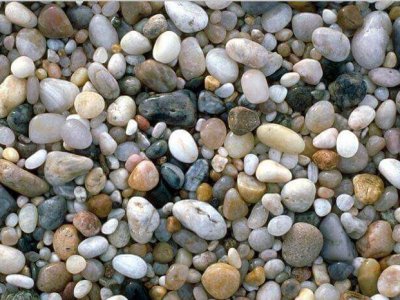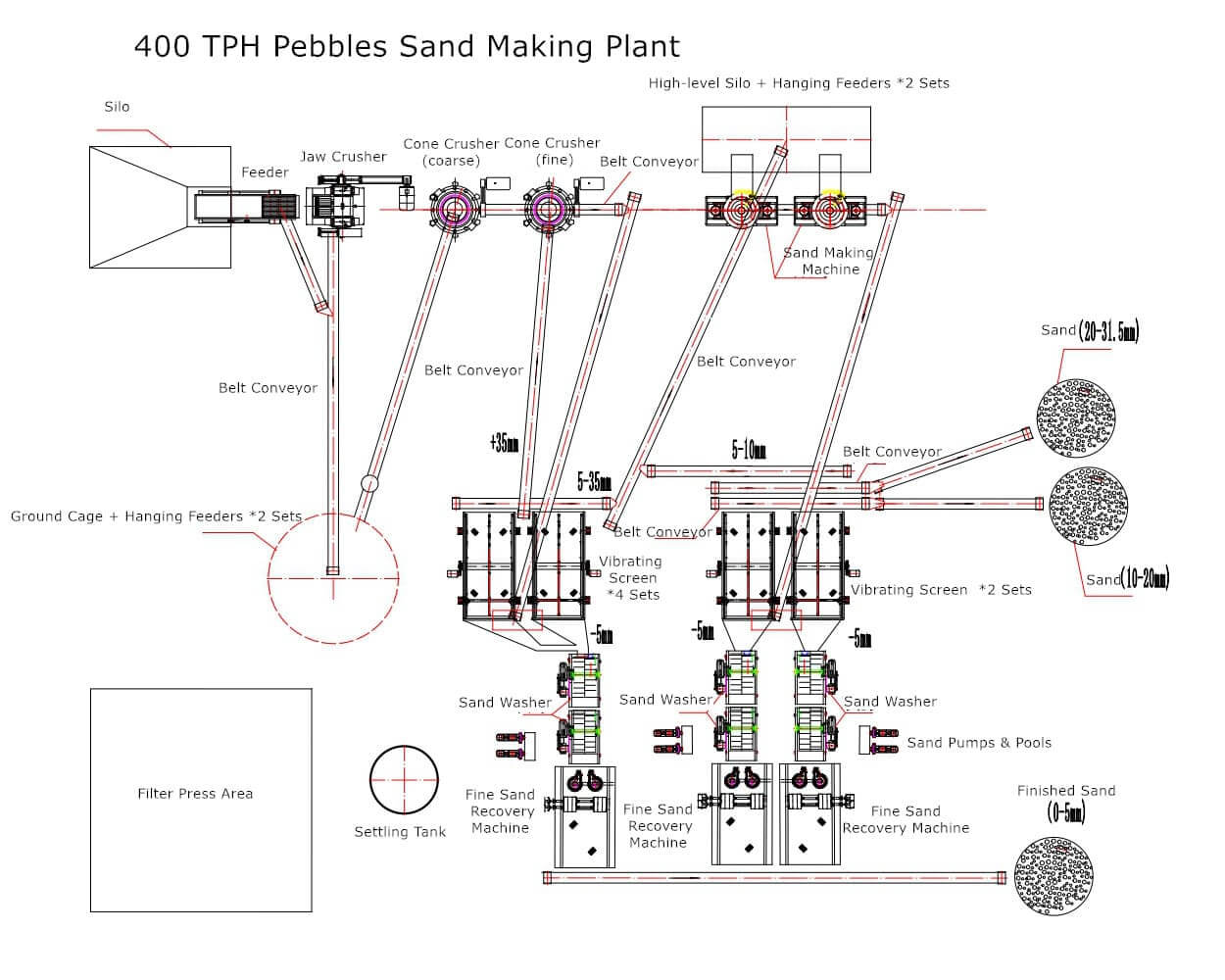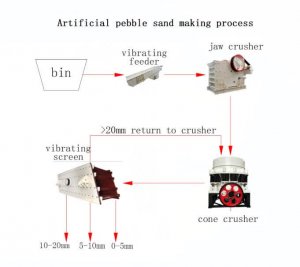This website uses cookies so that we can provide you with the best user experience possible. Cookie information is stored in your browser and performs functions such as recognising you when you return to our website and helping our team to understand which sections of the website you find most interesting and useful.
Home > Aggregates Processing Plant > Pebbles Sand Making Plant
River Pebbles Aggregates Processing

Material: River Pebbles
Application: It is suitable for construction applications in cement concrete, asphalt concrete and various stabilized soil, and also for highway engineering applications in road, tunnel, bridge and culvert, etc.
Equipment: Jaw crusher, cone crusher, sand-making machine, vibrating feeder, vibrating screen, sand washing machine, belt conveyor, etc.
Pebbles Introduction
River pebbles are hard solids shaped like goose eggs formed after tens of millions of years of the mountain, river impact, and water transport. They are hard, wear-resistant, and chemically stable silicate minerals. The main component is silicon. River pebbles are good in texture, hard in quality, and strong in pressure resistance and are widely used as raw materials for sand making.
The river pebbles sand made from river egg ore after a series of processes such as crushing, sand making, and screening is almost comparable to natural sand in terms of compressive strength, grain shape, and chromaticity. It is an important industrial mineral raw material and is widely used. It is used in water conservancy and hydropower engineering, high-grade highways, expressways, high-speed railways, dedicated passenger lines, bridges, airport runways, municipal engineering, high-rise building sand production, and stone shaping. River pebbles are rich in resources, the cost of collection is relatively low, and their application value is high. Therefore, sand-making from river pebbles is very popular in the market.
Pebbless’s Colors
The color of river pebbles varies depending on the minerals present in the surrounding area, but common colors include gray, brown, tan, and white.
Formation of Pebbles
Pebbles are formed due to weathering, erosion, and the transportation of running water.
The weathering breaks down rocks. Erosion is when weathered rock materials are transported and removed from their original location. Water, wind, ice, and gravity are the main agents of erosion. In the case of river pebbles, water is typically the primary agent. When water flows down from the high mountains, the high mountains are weathered and turned into gravel, sand, etc., which are transported to distant places by flowing water. The speed of the flowing water is slow, and the power of transport is reduced, especially in the middle and lower reaches of the river. The river water mostly transports the rocks in the river channel from the upper reaches. The rocks are impacted by the water and rubbed against each other, and the edges and corners of the rocks are lost and become very smooth, which forms pebbles.
Pebbles Composition
The main chemical composition of pebbles is silicon dioxide, followed by a small amount of iron oxide and traces of manganese, copper, aluminum, magnesium, and other elements and compounds.
Pebbles Sand Making Process
We divide the river pebble sand-making process into three stages: coarse and fine crushing, sand making and screening, and sand washing and recycling.
Coarse & Fine Crushing: In the first stage, the jaw crusher coarsely crushed the river pebbles. The coarsely crushed materials are screened by the vibrating screen and then transported by the belt conveyor to the second crushing machine(the cone crusher) for medium and fine crushing.
Sand Making & Screening: In the second stage, the crushed material is conveyed to the sand-making machine for fine crushing, and the finely crushed material is then screened through a circular vibrating screen to screen sand of different specifications, such as coarse sand, medium sand, and fine sand.
Sand Washing & Recycling: In the third stage, if the sand powder content is strict, a sand washing machine can be added behind the fine sand, and then the sewage discharged from the sand washing machine can be recovered through the fine sand recovery device.
Advantages of machine-made cobblestone sand
- Abundant raw materials, uniform materials, and pure ingredients without restriction. The mineral and chemical composition are consistent and less complex than natural sand.
- There is no need to mine and dig rocks, which can save a lot of work. The processing cycle is short, the investment cost is low, the finished product is three-dimensional, the grain shape is good, and the quality is controllable.
- People control the fineness modulus, which can be adjusted according to needs through the adjustment process, such as coarse sand (above 0.5mm), medium sand (0.5-0.35mm), fine sand (0.35-0.25mm), etc., which is beyond the reach of natural sand.
- The particle size is usually arc-shaped. When concrete is bonded to other structures, the bond is stronger, the effect of compressive strength is stronger, and the service life is longer.
Disadvantages of machine-made cobblestone sand
- Natural sand particles are round and smooth, and the fineness modulus of medium sand is mostly 2.6-3.0, which is conducive to the workability of concrete, while the cobblestone machine-made sand particles are sharp, angular, rough, and the fineness modulus is mostly greater than 3. 0, the particle gradation is slightly worse, and there are more particles greater than 2. 5 mm and less than 0.08 mm, resulting in poor concrete workability, prone to concrete appearance quality problems. Ithas brought certain difficulties to the control of construction quality, but its shortcomings can be overcome by selecting appropriate equipment, rationally utilizing the stone powder content in sand, adjusting the sand ratio, and selecting appropriate admixtures.
- Although it contains a certain amount of stone powder, the available methods include dry dust removal and wet water washing. The dry method is a dust collector, but this method is only suitable for the production of type III. Water washing is the key technology to produce high-quality machine-made sand, but attention should be paid to water saving and environmental protection. A proper amount of stone powder can be filled in the gap between cement and fine sand to enhance the workability of machine-made sand concrete. Generally, the sand powder content is less than 20%.







